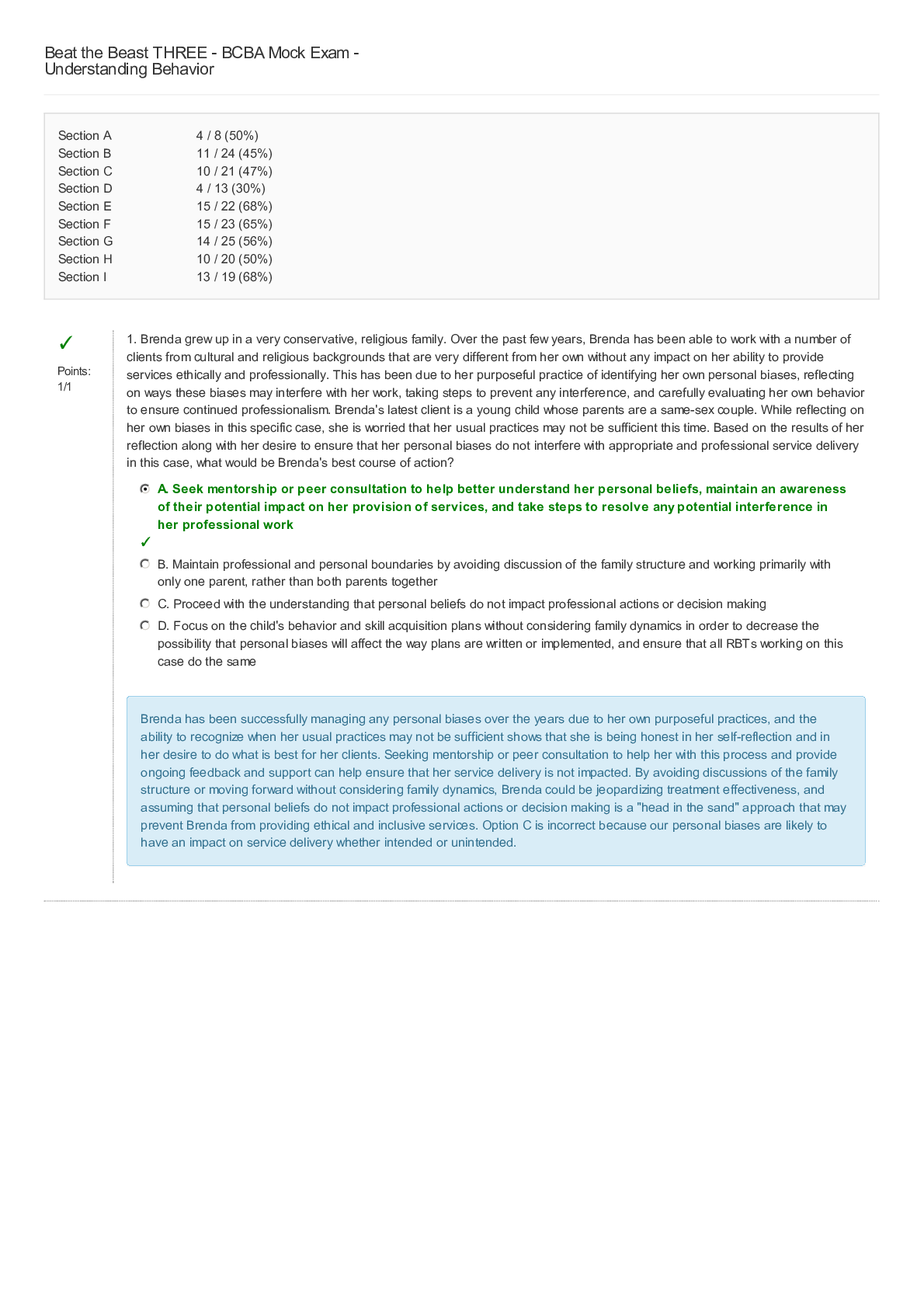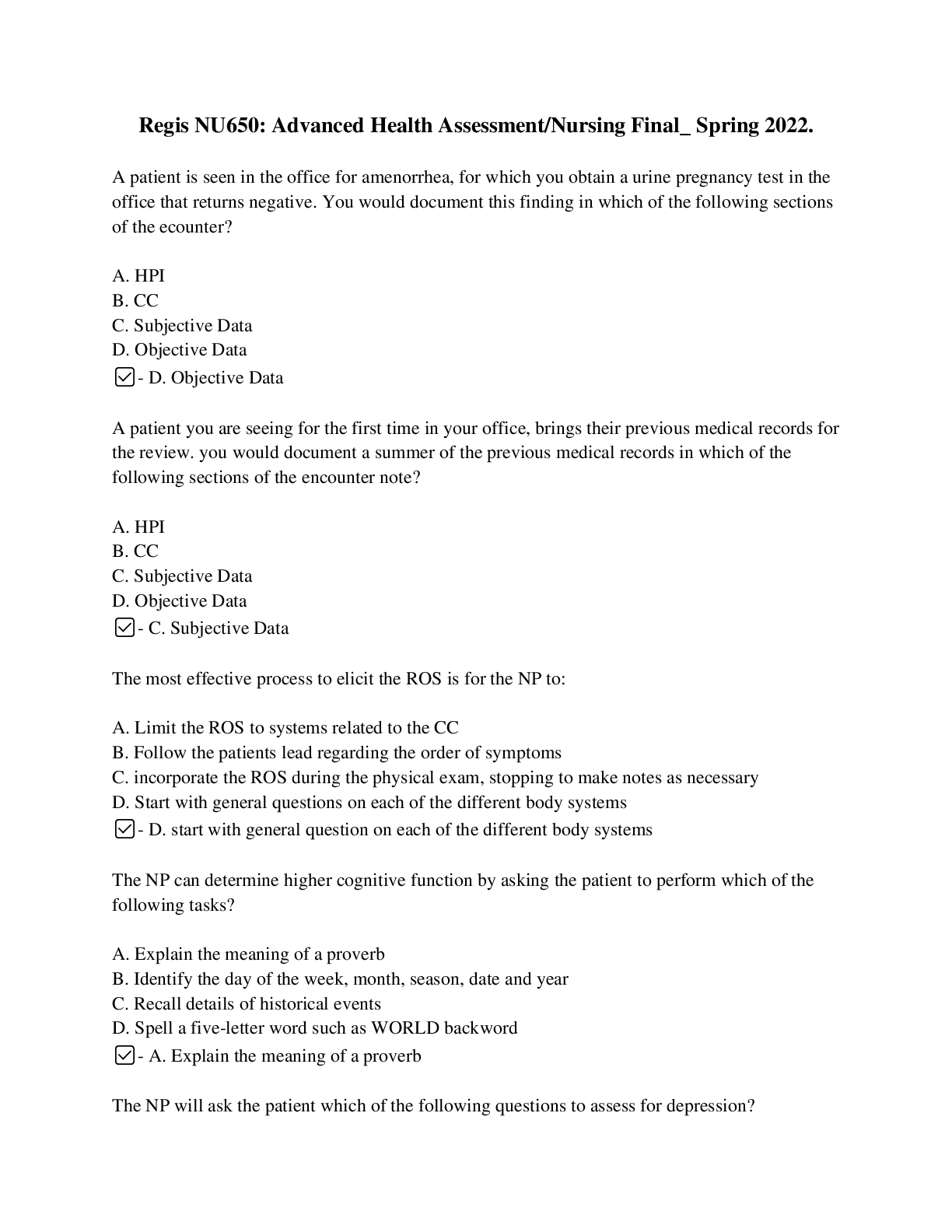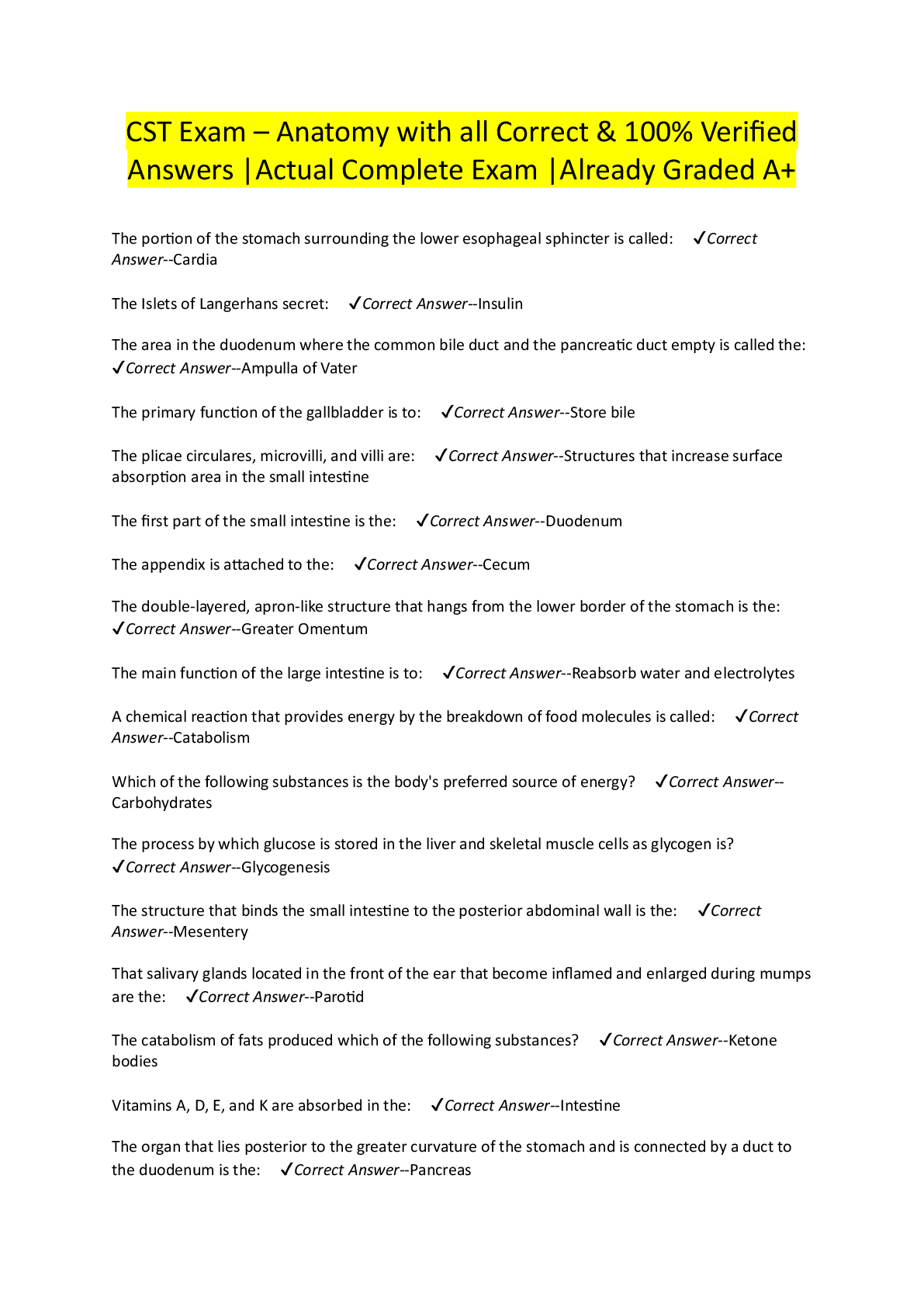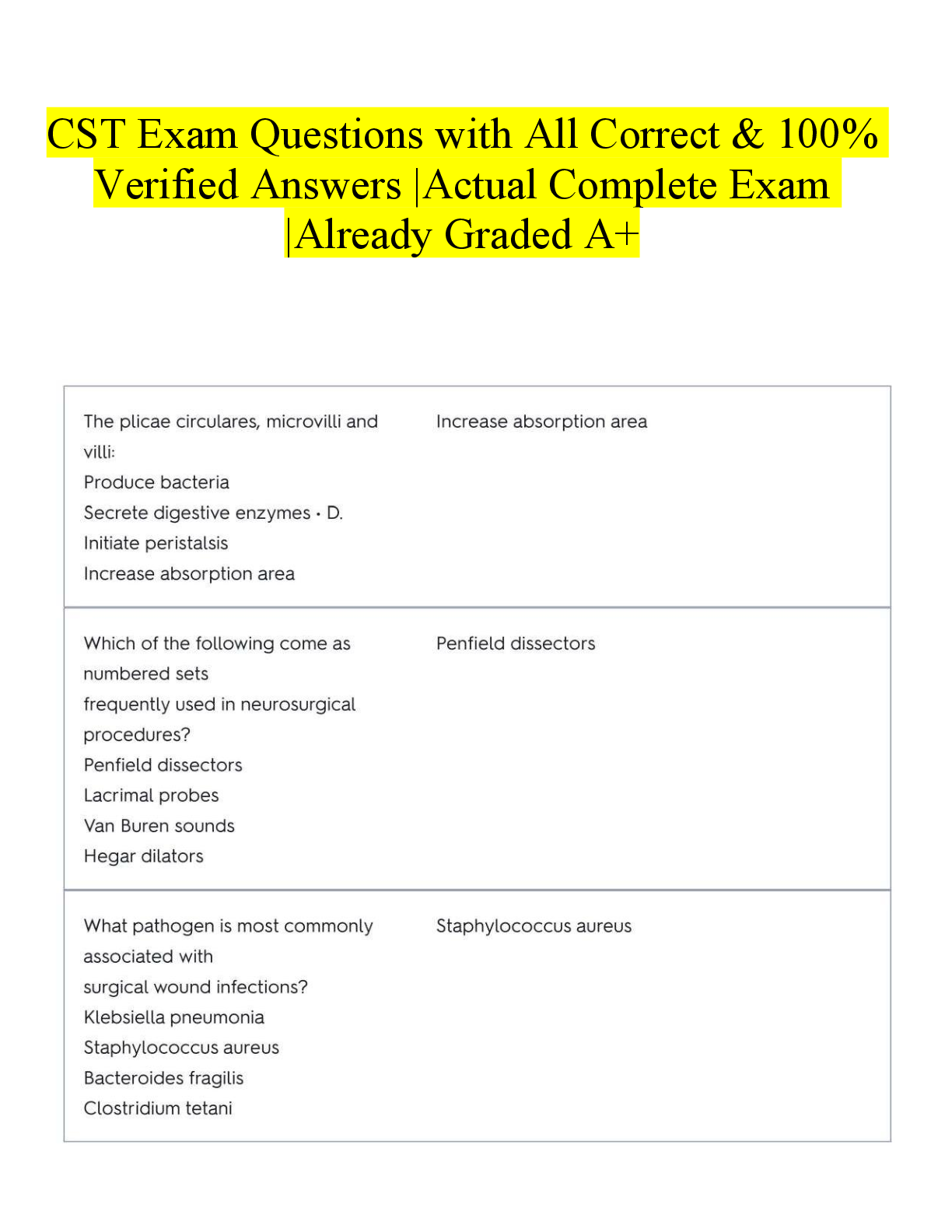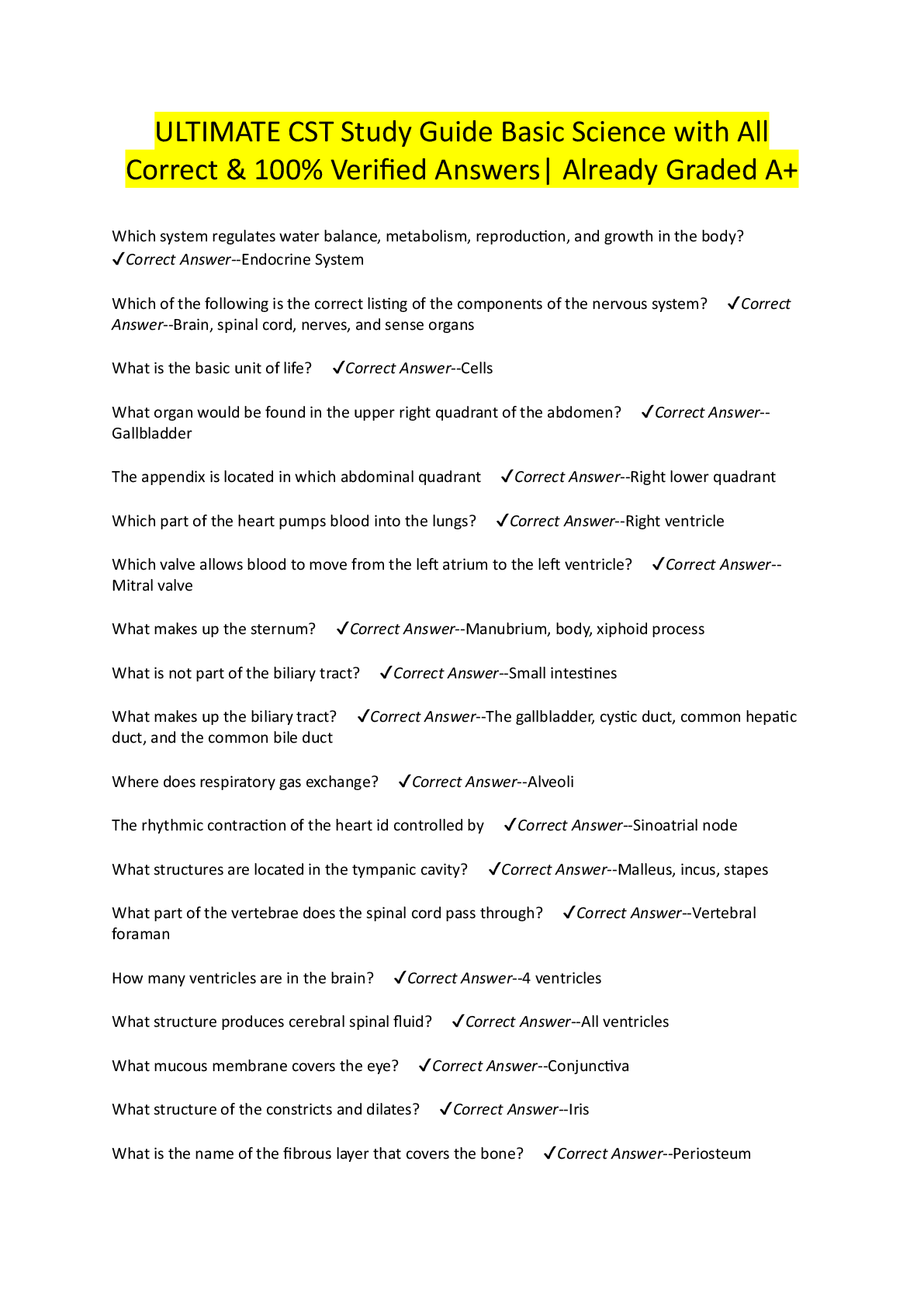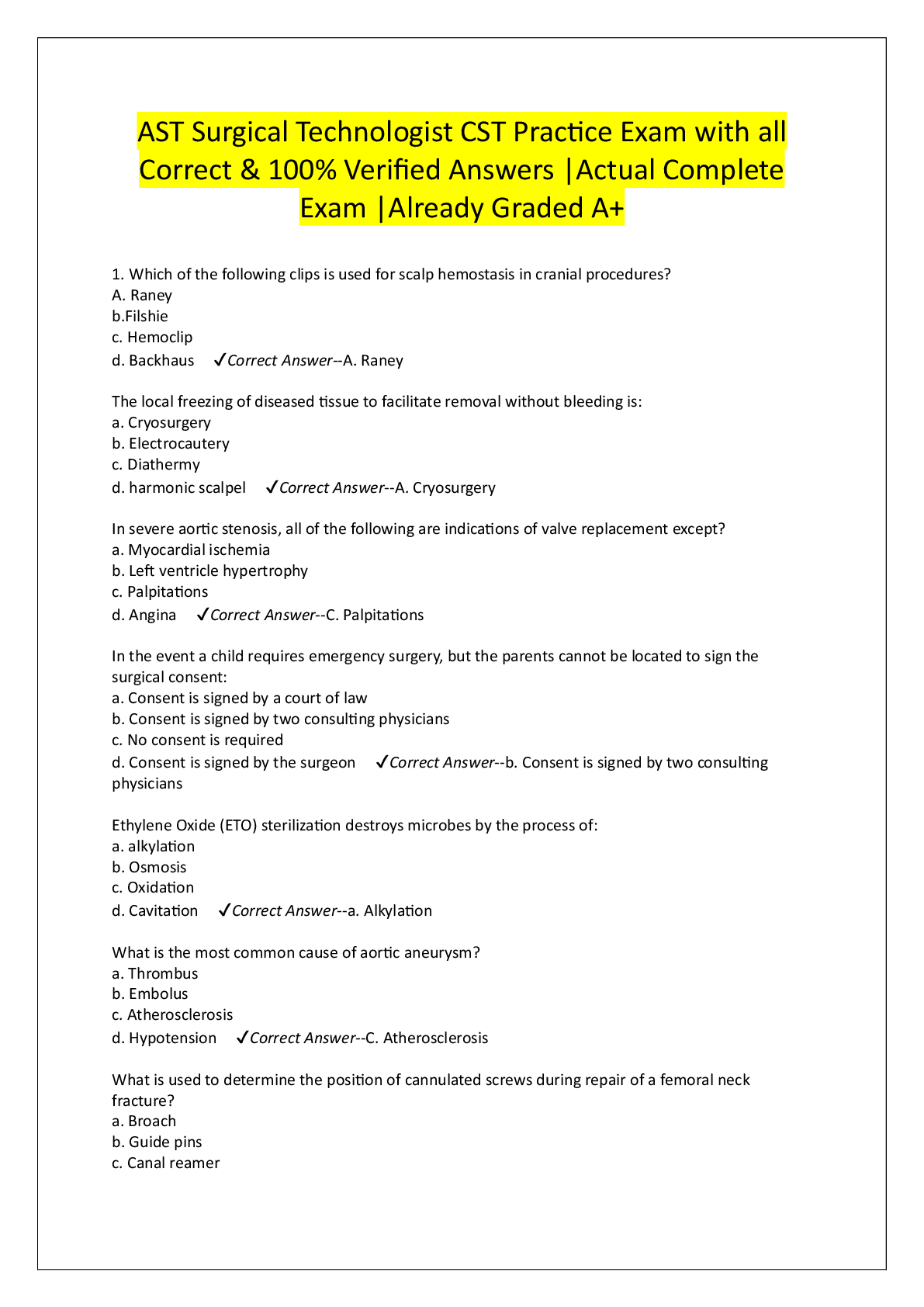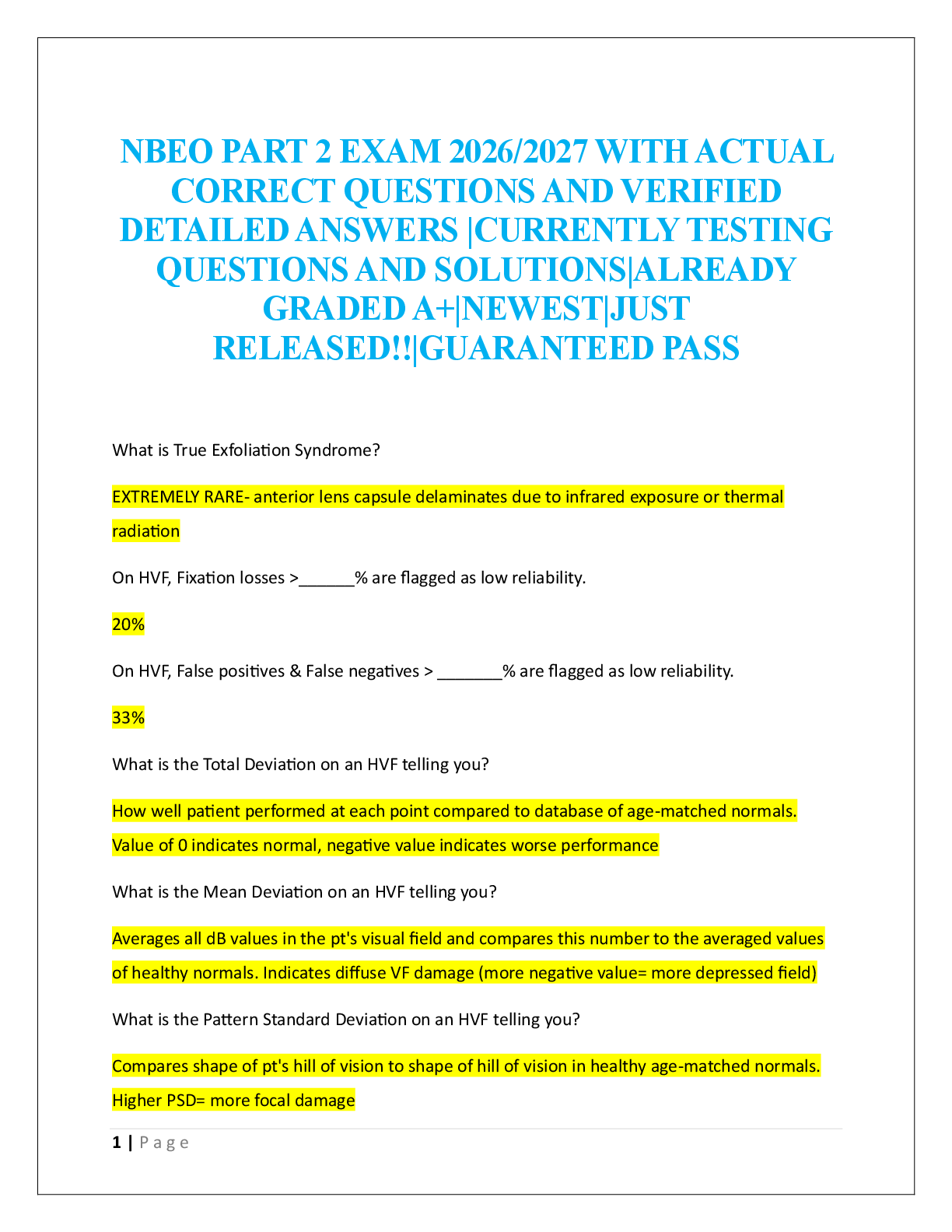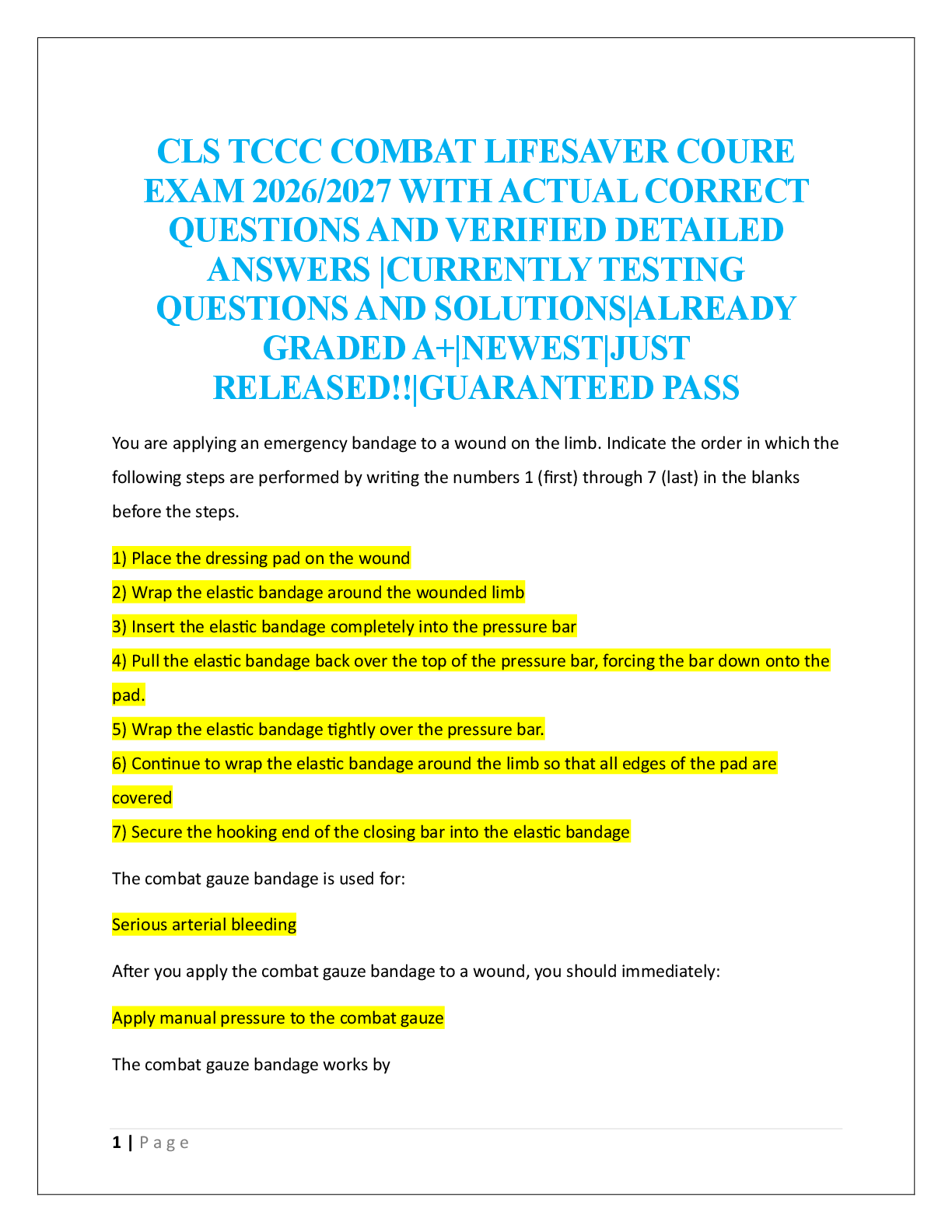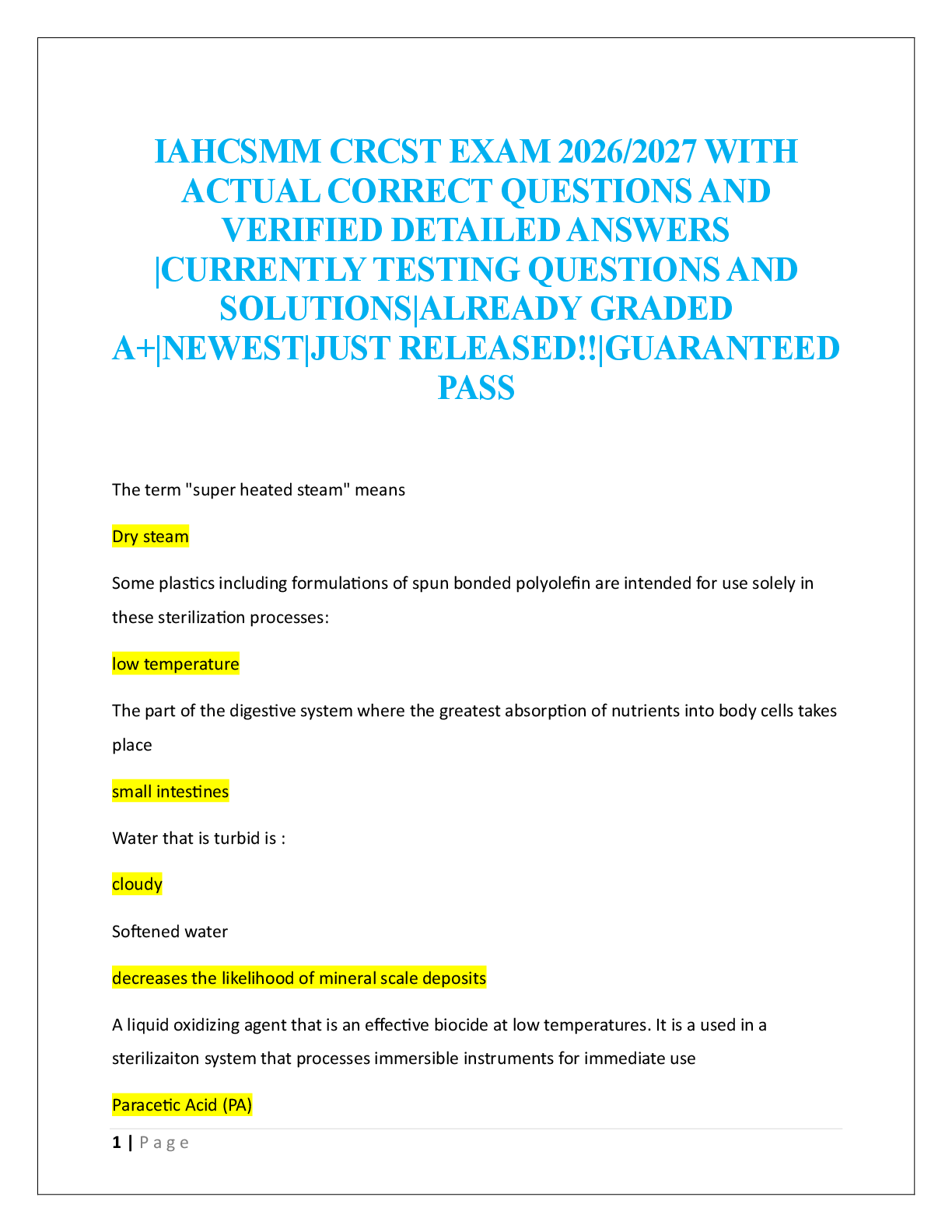Biology > EXAM > BIO251 Comprehensive Final Exam | BIO 251 Comprehensive Final Exam|Verified answers-100% correct. (All)
BIO251 Comprehensive Final Exam | BIO 251 Comprehensive Final Exam|Verified answers-100% correct.
Document Content and Description Below
BIO251 Comprehensive Final Exam Part 1 of 10 - Part 1 5.0/ 5.0 Points From chapter 1 Question 1 of 75 1.0/ 1.0 Points The following are all levels of the structural organization of the human ... body: 1. Organ 2. Organ system 3. Tissue 4. Cell 5. Chemical level Arrange the above levels from least complex to most complex: • A. 3, 4, 1, 2, 5 • B. 4, 5, 1, 2, 3 • C. 5, 4, 3, 1, 2 • D. 1, 2, 3, 4, 5 • E. 5, 4, 6, 2, 1 Feedback: Good work; your answer is correct! Question 2 of 75 1.0/ 1.0 Points Which of the following statement(s) is(are) correct? • A. Anabolism is a process in which complex structures or molecules are broken down into much simpler ones. • B. Catabolism is a process in which simple molecules can be combined to form more complex molecules or tissues. • C. Metabolism is the sum of all anabolic and catabolic reactions that take place in the body. • D. A waste product of all the reactions that take place in a cell is the molecule ATP. • E. All of the above statements are correct. Feedback: Good work; your answer is correct! Question 3 of 75 1.0/ 1.0 Points Every cell in an animal is separated from other cells and from the extracellular environment by a cell (plasma) membrane. Which of the following are found inside the cell membrane? • A. cilia • B. blood • C. cellular fluids • D. organelles • E. Both C and D are correct. Feedback: Good work; your answer is correct! Question 4 of 75 1.0/ 1.0 Points Which of the following statement(s) is(are) correct? • A. Regional anatomy is the study of the interrelationships of all of the structures in a specific body region • B. Systemic anatomy is the study of the structures that make up a discrete body system. • C. Your study of anatomy and physiology will make more sense if you continually relate the form of the structures you are studying to their function. • D. Like most scientific disciplines, anatomy has areas of specialization. • E. All of the above statements are true. Feedback: Good work; your answer is correct! Question 5 of 75 1.0/ 1.0 Points Almost all of the liver of a human being is located in which abdominopelvic quadrant? • A. Right upper quadrant (RUQ) • B. Left upper quadrant (LUQ) • C. Right lower quadrant (RLQ) • D. Epigastric quadrant • E. Left lower quadrant (LLQ) Feedback: Good work; your answer is correct! Part 2 of 10 - Part 2 5.0/ 5.0 Points From chapter 2 Question 6 of 75 1.0/ 1.0 Points Which of the following types of substances dissolve in water? • A. Hydrophobic • B. Nonpolar covalent substances • C. Hydrophilic Feedback: Correct. This can be found in the OpenStax Overview of Anatomy and Physiology section. Section 2.4. Question 7 of 75 1.0/ 1.0 Points Which of the following do all amino acids have in common? • A. An amine group and a carboxyl group • B. A sulfur atom • C. Match in size and are polar • D. The same “R” group Feedback: Correct. This can be found in the OpenStax Overview of Anatomy and Physiology section. Section 2.5. Question 8 of 75 1.0/ 1.0 Points Which of the following is NOT a part of the nucleotides that make up DNA? • A. Amino group • B. Nitrogenous base • C. Phosphate group • D. Sugar unit Feedback: Correct. This can be found in the OpenStax Overview of Anatomy and Physiology section. Section 2.5. Question 9 of 75 1.0/ 1.0 Points A substance formed of crystals of equal numbers of cations and anions held together by ionic bonds is called what? • A. Dipole • B. Electrolyte • C. Noble gas • D. Salt Feedback: Correct. This can be found in the OpenStax Overview of Anatomy and Physiology section. Section 2.2. Question 10 of 75 1.0/ 1.0 Points All proteins are made of repeating units of ________. • A. Amino acids • B. Collagen • C. Glucose • D. Nitrogen Feedback: Correct. This can be found in the OpenStax Overview of Anatomy and Physiology section. Section 2.5. Part 3 of 10 - Part 3 4.0/ 5.0 Points From chapter 3 Question 11 of 75 1.0/ 1.0 Points Human sex cells (sperm or egg) contain _____ chromosomes. All other cells contain _____ chromosomes. • A. 24; 48 • B. 22; 44 • C. 23; 46 • D. 30; 60 • E. 25; 50 Feedback: Good work; your answer is correct! Question 12 of 75 1.0/ 1.0 Points Which type of stem cell gives rise to red and white blood cells? • A. hematopoietic • B. mesenchymal • C. blood • D. endothelial • E. epithelial Feedback: Good work; your answer is correct! Question 13 of 75 0.0/ 1.0 Points The cells that make up nearly all of the body contain an equal number of chromosomes that they receive from each parent. These are called ________ cells. • A. Bipolar cells • B. Duplex cells • C. Sex cells • D. Mitotic cells • E. Somatic cells Feedback: A somatic cell is a general term for a body cell, and all human cells, except for the cells that produce eggs and sperm (which are referred to as germ cells), are somatic cells. Somatic cells contain two copies of each of their chromosomes (one copy received from each parent). Question 14 of 75 1.0/ 1.0 Points Which of the following are organelles found inside of an animal cell? • A. nucleus • B. mitochondria • C. Golgi apparatus • D. ribosome • E. All of the above Feedback: Good work; your answer is correct! Question 15 of 75 1.0/ 1.0 Points What scientist is given credit for coming up with the concept of the cell? • A. Albert Einstein • B. Galileo • C. Michelangelo • D. Michael Curie • E. Robert Hooke Feedback: Good work; your answer is correct! Part 4 of 10 - Part 4 5.0/ 5.0 Points From chapter 4 Question 16 of 75 1.0/ 1.0 Points The embryonic tissue level, mesoderm, gives rise to which of the following type(s) of tissue? • A. Skin cells • B. Neurons • C. Skeletal muscle • D. Thyroid cells • E. All of the above Feedback: Good work; your answer is correct! Question 17 of 75 1.0/ 1.0 Points The basic types of cell-to-cell junctions between epithelial cells are ________. • A. Tight junctions • B. Gap junctions • C. Anchoring junctions • D. Fixed junctions • E. A, B, and C are all correct. Feedback: Good work; your answer is correct! Question 18 of 75 1.0/ 1.0 Points Which of the following statements is/are true about nervous tissue? • A. A neuron is able to propagate nerve impulses. • B. A neuroglial cell is a supportive cell. • C. The cell body of a neuron is called the soma. • D. All of the above statements are true. • E. Only A and B are true. Feedback: Good work; your answer is correct! Question 19 of 75 1.0/ 1.0 Points The cells responsible for the transmission of the nerve impulse are ________. • A. astrocytes • B. microglia • C. neurons • D. transmission cells • E. oligodendrocytes Feedback: Good work; your answer is correct! Question 20 of 75 1.0/ 1.0 Points Which of the following is the epithelial tissue that lines the interior of blood vessels? • A. simple squamous • B. columnar • C. transitional • D. pseudostratified • E. stratified Feedback: Good work; your answer is correct! Part 5 of 10 - Part 5 5.0/ 5.0 Points From chapter 12 Question 21 of 75 1.0/ 1.0 Points The division of the nervous system that includes the brain and the spinal cord is the _________ nervous system. • A. autonomic • B. parasympathetic • C. central • D. peripheral • E. sympathetic Feedback: Good work; your answer is correct! Question 22 of 75 1.0/ 1.0 Points Which part of a neuron transmits an electrical signal to a target cell? • A. dendrites • B. soma • C. cell body • D. axon • E. ganglion Feedback: Good work; your answer is correct! Question 23 of 75 1.0/ 1.0 Points The resting membrane potential is primarily due to the differences in concentrations of which ions? • A. Calcium and sodium • B. Proteins and potassium • C. Calcium and phosphate • D. Sodium and potassium • E. Sodium and proteins Feedback: Good work; your answer is correct! Question 24 of 75 1.0/ 1.0 Points Which of the following voltages would most likely be measured during the relative refractory period? • A. -45 mV • B. +30 mV • C. -30 mV • D. -80 mv • E. 0 mV Feedback: Good work; your answer is correct! Question 25 of 75 1.0/ 1.0 Points Voltage-gated sodium channels open upon reaching what state? • A. Overshoot • B. Repolarization • C. Resting potential • D. Threshold Feedback: Correct. This can be found in the OpenStax Overview of Anatomy and Physiology section. Section 12.4. Part 6 of 10 - Part 6 15.0/ 15.0 Points From chapter 17 Question 26 of 75 1.5/ 1.5 Points The female’s uterus secretes the following hormone: • A. Progesterone • B. FSH • C. Estrogen • D. hPL • E. None Feedback: Good work; your answer is correct! Question 27 of 75 1.5/ 1.5 Points The gonads produce what class of hormones? • A. amine hormones • B. steroid hormones • C. neurotransmitters • D. peptide hormones • E. catecholamines Feedback: Good work; your answer is correct! Question 28 of 75 1.5/ 1.5 Points The parathyroid glands are tiny, round structures usually found embedded in the posterior surface of the ___________. • A. Hypothalamus • B. Thyroid gland • C. Pituitary gland • D. Pancreas • E. Adrenal glands Feedback: Good work; your answer is correct! Question 29 of 75 1.5/ 1.5 Points What secretory cell type is found in the adrenal medulla? • A. follicle cells • B. neuroglial cells • C. oxyphil cells • D. chromaffin cells • E. beta cells Feedback: Good work; your answer is correct! Question 30 of 75 1.5/ 1.5 Points Which of the following statements about the thyroid gland is true? • A. It is located anterior to the trachea and inferior to the larynx. • B. The parathyroid glands are embedded within it. • C. It manufactures three hormones. • D. It is controlled by the anterior part of the pituitary gland. • E. All of the above are true. Feedback: Good work; your answer is correct! Question 31 of 75 1.5/ 1.5 Points Which general type of hormone can easily pass through the cell membrane and into the cytoplasm of the cell? • A. Pituitary hormones • B. Lipid-soluble hormones • C. Protein hormones • D. Water-soluble hormones • E. CNS hormones Feedback: Good work; your answer is correct! Question 32 of 75 1.5/ 1.5 Points The parathyroid glands are small structures located on the posterior thyroid gland that produce parathyroid hormone (PTH), which regulates blood ________ levels. • A. potassium • B. calcium • C. insulin • D. adrenalin • E. thyroid hormone Feedback: Good work; your answer is correct! Question 33 of 75 1.5/ 1.5 Points The development of a goiter indicates that ________. • A. the anterior pituitary is abnormally enlarged • B. there is hypertrophy of the thyroid’s follicle cells • C. there is an excessive accumulation of colloid in the thyroid follicles • D. the anterior pituitary is secreting excessive growth hormone • E. Both B and C are correct. Feedback: Good work; your answer is correct! Question 34 of 75 1.5/ 1.5 Points Cushing’s disease is a disorder caused by ________. • A. abnormally low levels of cortisol • B. abnormally low levels of aldosterone • C. abnormally high levels of cortisol • D. abnormally high levels of aldosterone • E. abnormally high levels of epinephrine Feedback: Good work; your answer is correct! Question 35 of 75 1.5/ 1.5 Points Which of the following is an anterior pituitary hormone? • A. ADH • B. TSH • C. Insulin • D. Cortisol • E. oxytocin Feedback: Good work; your answer is correct! Part 7 of 10 - Part 7 10.5/ 15.0 Points From chapter 19 Question 36 of 75 1.5/ 1.5 Points One of the most important ways of investigating the function of the heart is called the “cardiac output.” Which of the following facts is/are true? • A. Cardiac output, CO, is determined by multiplying the heart rate, HR, by the amount of blood that is pumped out of the left ventricle with each heart contraction, called “stroke volume” and designated as SV. • B. Is almost impossible to measure. • C. It cannot be measured without using very dangerous and invasive methods. • D. The CO will never change in any one individual. • E. All of the above are true. Feedback: Good work; your answer is correct! Question 37 of 75 0.0/ 1.5 Points A cardiac muscle cell is: • A. a voluntary muscle just like skeletal muscle. • B. contracts spontaneously. • C. is joined to other cardiac muscle cells by structures called intercalated discs. • D. has numerous nuclei. • E. Two of the statements above are correct. Feedback: Cardiac muscle cells are totally involuntary and contract only when depolarized by electrical signals travelling from another source. Each cell has one or possibly two or three nuclei. They are highly dependent on the atom calcium. Question 38 of 75 1.5/ 1.5 Points Let the left atrium = 1; the right atrium = 2; the left ventricle = 3; the right ventricle = 4. Blood then would flow through the heart in the following order: • A. 3, 4, 2, 1 • B. 4, 3, 2, 1 • C. 2, 4, 1, 3 • D. 1, 2, 3, 4 • E. 2, 1, 3, 4 Feedback: Good work; your answer is correct! Question 39 of 75 0.0/ 1.5 Points The opening of any heart valve only occurs when: • A. the cardiac muscle surrounding the valve contracts. • B. blood tries to flow in an incorrect/opposite direction. • C. the blood pressure in the heart chamber from which blood is flowing is higher than the blood pressure in the chamber to which the blood is supposed to flow. • D. papillary muscles push it open. • E. the chordae tendinae pull it open. Feedback: The papillary muscles and chordae tendinae attached to a valve keep that valve from opening in an incorrect direction. When the valve is closed, the blood is not allowed to flow in an incorrect direction. Only a pressure difference will cause any valve to open. Question 40 of 75 1.5/ 1.5 Points The period of time that begins with contraction of the atria and ends with ventricular relaxation is known as: • A. diastole. • B. the cardiac cycle. • C. the P-wave. • D. systole. • E. an ECG. Feedback: Good work; your answer is correct! Question 41 of 75 1.5/ 1.5 Points Which of the following statements about the internal structure of the heart is/are correct? • A. The mitral valve is a bicuspid valve. • B. The mitral valve is located between the left atrium and the left ventricle. • C. The aortic valve is one of the semilunar valves. • D. The tricuspid valve is located between the vena cavae and the right atrium. • E. A, B, and C are correct. Feedback: Good work; your answer is correct! Question 42 of 75 1.5/ 1.5 Points Which of the following parts of an ECG represents the depolarization of the atria? • A. The T-wave • B. The PR-interval • C. The QRS-complex • D. The P-wave • E. The ST interval Feedback: Good work; your answer is correct! Question 43 of 75 1.5/ 1.5 Points Which of the following statements about the circulatory system is/are correct? • A. The pulmonary circulatory system starts in the pulmonary trunk as the blood leaves the right ventricle and ends as the blood flows back into the left atrium. • B. The systemic circulatory system begins in the aorta as the blood leaves the left ventricle and ends as the blood returns to the right atrium. • C. The pulmonary arteries carry less oxygen than do the pulmonary veins. • D. The aorta is the largest blood vessel that exits from the heart. • E. All the above statements are true. Feedback: Good work; your answer is correct! Question 44 of 75 0.0/ 1.5 Points Which of the following statement(s) is (are) true? • A. The force the heart must overcome in order to pump blood is known as the its stroke volume. • B. The term preload refers to a tension, or pressure, that the left ventricle must develop in order for the heart to function properly. • C. The preload and afterload are the primary factors that cause the heart rate to change. • D. Contractility of the heart muscle refers to the force of contraction that this muscle can exert. • E. Both C and D are true. Feedback: Contractility refers to the force of the contraction of the heart muscle. Question 45 of 75 1.5/ 1.5 Points A pacemaker, which depolarizes spontaneously, establishes the rate of contraction of the heart muscle. The most common pacemaker of the heart • A. is called the AV node. • B. establishes a resting heart rate of about 60 to 80 contractions per minute. • C. functions also under the control of both the sympathetic and the parasympathetic nervous systems. • D. is located in the muscle of the left atrium. • E. Two of the above are true. Feedback: Good work; your answer is correct! Part 8 of 10 - Part 8 15.0/ 15.0 Points From chapter 22 Question 46 of 75 1.5/ 1.5 Points What would happen if the body allowed us to exhale all of the air out of our lungs? • A. Nothing, we could easily fill them up when we inhaled again • B. The alveoli would collapse • C. The trachea would collapse • D. All of the above • E. None of the above Feedback: Good work; your answer is correct! Question 47 of 75 1.5/ 1.5 Points The blood traveling to the lungs is generally described to be which of the following? • A. Oxygenated • B. Deoxygenated • C. Neither oxygenated or deoxygenated • D. Both oxygenated and deoxygenated • E. None of the terms above would ever be used to describe blood in the body Feedback: Good work; your answer is correct! Question 48 of 75 1.5/ 1.5 Points The oropharynx is a passageway for which of the following? • A. Air only • B. Food only • C. Both air and food • D. Neither air nor food • E. None of the above Feedback: Good work; your answer is correct! Question 49 of 75 1.5/ 1.5 Points _________ percent of CO2 is transported to the lungs bound by hemoglobin. • A. 10 • B. 70 • C. 5 • D. 30 • E. 20 Feedback: Good work; your answer is correct! Question 50 of 75 1.5/ 1.5 Points Which of the following are some of the functions of the respiratory system? • A. Helps to maintain acid-base balance • B. Provides oxygen to body tissues and removes waste such as CO2 • C. Helps in sensing odors • D. Helps in the production of speech • E. All of the above Feedback: Good work; your answer is correct! Question 51 of 75 1.5/ 1.5 Points Under normal circumstances, bronchoconstriction is caused by ________________ and bronchodilation is caused by ________________. • A. Sympathetic nervous system; parasympathetic nervous system • B. Parasympathetic nervous system; sympathetic nervous system • C. Voluntary control; involuntary control • D. Involuntary control; voluntary control • E. None of the above Feedback: Good work; your answer is correct! Question 52 of 75 1.5/ 1.5 Points Which of the following are ways CO2 is transported in the blood? • A. As bicarbonate (HCO3–) • B. As dissolved C02 in plasma • C. As carbaminohemoglobin • D. All of the above • E. None of the above Feedback: Good work; your answer is correct! Question 53 of 75 1.5/ 1.5 Points At a birthday party, a teen decides to inhale some of the helium from a nearby balloon using his mouth. Before the helium gas reaches his right and left lungs, through which order of structures will it flow? • A. Oral cavity to the trachea to the trachea to the nasopharynx to the right and left main bronchi • B. Oral cavity to the oropharynx to the trachea to the right and left main bronchi • C. Oral cavity to the nasopharynx to the trachea to the right and left main bronchi • D. Oral cavity to the right and left main bronchi to the trachea to the oropharynx • E. Oral cavity to the trachea to the larynx to the right and left main bronchi Feedback: Good work; your answer is correct! Question 54 of 75 1.5/ 1.5 Points ____________ is the maximum amount of air one can exhale by force after a normal expiration. • A. Vital capacity • B. Expiratory reserve volume • C. Tidal volume • D. Inspiratory reserve volume • E. Residual volume Feedback: Good work; your answer is correct! Question 55 of 75 1.5/ 1.5 Points How many molecules of oxygen can one molecule of hemoglobin carry? • A. 3 • B. 1 • C. 5 • D. 4 • E. 2 Feedback: Good work; your answer is correct! Part 9 of 10 - Part 9 15.0/ 15.0 Points From chapter 23 Question 56 of 75 1.5/ 1.5 Points The correctly sequenced sections of the small intestine are: ____________, _____________, ____________. • A. Duodenum; jejunum; ileum • B. Ileum, jejunum; duodenum • C. Duodenum; ileum; jejunum • D. Jejunum; duodenum; ileum • E. None of the above is correct Feedback: Good work; your answer is correct! Question 57 of 75 1.5/ 1.5 Points The two regulatory mechanisms (controls) of the digestive system are _________ and __________. • A. Neural and hormonal • B. Hormonal and enzymatic • C. Neural and enzymatic • D. The digestive system only has enzymatic control and nothing else • E. None of the above Feedback: Good work; your answer is correct! Question 58 of 75 1.5/ 1.5 Points Our body’s ability to absorb vitamins from foods and supplements we take is vital to our health. Why do you think consuming some fat in the diet is important? • A. We need fat to help with absorption of fat-soluble vitamins such as A, D, E, and K • B. We need fat to help with absorption of water-soluble vitamins such as C, B1, B6 and B9 • C. We need fat to help with absorption of protein • D. We need fat to help with absorption of fiber • E. None of the above Feedback: Good work; your answer is correct! Question 59 of 75 1.5/ 1.5 Points The stomach is protected from self-digestion by the ______________. When this breaks down, _________ can form and be painful. • A. Muscularis mucosa; nodules • B. Mucosal barrier; ulcers • C. Duodenum; ulcers • D. Serosa; nodules • E. None of the above is correct Feedback: Good work; your answer is correct! Question 60 of 75 1.5/ 1.5 Points The ___________ is the thin layer of the mucosa responsible for pulling the mucosa into its many folds which increases the surface area of the alimentary canal. • A. Muscularis (externa) • B. Submucosa • C. Serosa • D. Muscularis mucosa • E. None of the above Feedback: Good work; your answer is correct! Question 61 of 75 1.5/ 1.5 Points What helps to break down the fat we eat during digestion? • A. Lipases • B. Salivary amylase • C. Pepsin • D. Pepsinogen • E. None of the above Feedback: Good work; your answer is correct! Question 62 of 75 1.5/ 1.5 Points Which of the following is not considered an accessory organ of digestion? • A. Pancreas • B. Large intestine • C. Gallbladder • D. Liver • E. None of the above are considered accessory organs of digestion Feedback: Good work; your answer is correct! Question 63 of 75 1.5/ 1.5 Points Food makes its way from the esophagus into the stomach. Before passing into the stomach it must go through the ___________ . • A. Lower esophageal sphincter • B. Oropharynx • C. Trachea • D. Upper esophageal sphincter • E. Duodenum Feedback: Good work; your answer is correct! Question 64 of 75 1.5/ 1.5 Points The ________ secretes _________ into the _________. • A. Liver; gastrin; pancreatic duct • B. Pancreas; pepsinogen; common hepatic duct • C. Gallbladder; bile; common bile duct • D. Pancreas; bile; pancreatic duct • E. None of the above Feedback: Good work; your answer is correct! Question 65 of 75 1.5/ 1.5 Points How many lobes does the liver have? • A. 1 • B. 4 • C. 2 • D. 5 • E. 3 Feedback: Good work; your answer is correct! Part 10 of 10 - Part 10 15.0/ 15.0 Points From chapter 25 Question 66 of 75 1.5/ 1.5 Points A normal urinalysis would include each of the following: • A. pH of 3 to 6 • B. pale yellow to deep amber color • C. odorless • D. specific gravity of 1.003–1.032 • E. B, C, and D are correct Feedback: Good work; your answer is correct! Question 67 of 75 1.5/ 1.5 Points Which of the following statement(s) is/are true of the kidney? • A. Each kidney is approximately the same size as an adult’s fist. • B. Is located posterior to the abdominal peritoneum. • C. Are well protected by ribs 10 – 12. • D. Is very poorly vascularized. • E. A, B, and C are correct. Feedback: Good work; your answer is correct! Question 68 of 75 1.5/ 1.5 Points A normal daily urine output should be: • A. 2 –3 L • B. 500 – 800 mL • C. 3 – 4 L • D. 1 – 2 L • E. 200 – 500 mL Feedback: Good work; your answer is correct! Question 69 of 75 1.5/ 1.5 Points Urine is produced by the kidneys because of fluid that flows through which of the following? • A. Bowman’s capsule • B. Proximal convoluted tubule • C. Loop of Henle • D. Distal convoluted tubule • E. All of the above are involved in sequence. Feedback: Good work; your answer is correct! Question 70 of 75 1.5/ 1.5 Points Renin is released in response to ________. • A. low red blood cell count • B. decreased blood pressure • C. diuretics • D. ACE • E. increased blood pressure Feedback: Good work; your answer is correct! Question 71 of 75 1.5/ 1.5 Points Peristaltic contractions occur in the ________. • A. urethra • B. urinary bladder • C. ureters • D. renal pelvis • E. A, B, and C are correct Feedback: Good work; your answer is correct! Question 72 of 75 1.5/ 1.5 Points The urinary system has some of the following roles in the human body: • A. Ridding the body of wastes • B. Regulation of blood pH • C. Regulation of blood pressure • D. Stimulate the production of red blood cells • E. All of the above are true. Feedback: Good work; your answer is correct! Question 73 of 75 1.5/ 1.5 Points The functional unit of the kidney is called the ________. • A. Bowman’s capsule • B. renal corpuscle • C. nephron • D. Loop of Henle • E. renal hilus Feedback: Good work; your answer is correct! Question 74 of 75 1.5/ 1.5 Points The renal ________ is the entry and exit site for structures servicing the kidneys. • A. Pelvis • B. Medulla • C. Hilum • D. Cortex • E. None of the above is true. Feedback: Good work; your answer is correct! Question 75 of 75 1.5/ 1.5 Points The volume of filtrate formed by both kidneys per minute is termed the ______________ . • A. uremic coefficient • B. anuric coefficient • C. glomerular filtration rate (GFR) • D. filtration quantity • E. None of the above Feedback: Good work; your answer is correct! [Show More]
Last updated: 3 years ago
Preview 1 out of 51 pages

Buy this document to get the full access instantly
Instant Download Access after purchase
Buy NowInstant download
We Accept:

Reviews( 0 )
$18.00
Can't find what you want? Try our AI powered Search
Document information
Connected school, study & course
About the document
Uploaded On
Jun 18, 2020
Number of pages
51
Written in
All
Additional information
This document has been written for:
Uploaded
Jun 18, 2020
Downloads
0
Views
195

